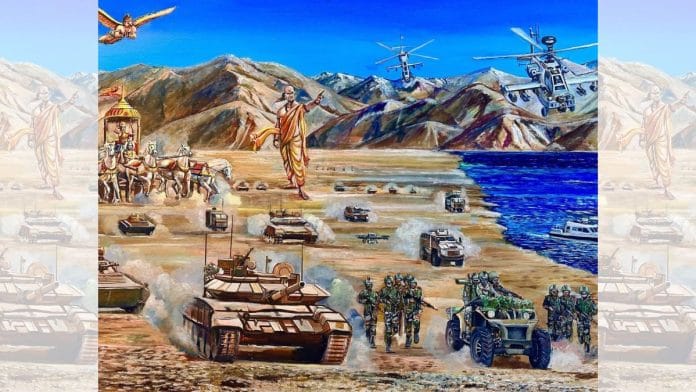New Delhi: The chief of Army staff’s (COAS) office now sports a painting titled ‘Karm Kshetra’ or ‘Field of Deeds’, showing Pangong Tso and India’s offensive capabilities along the Line of Actual Control (LAC) with China. Sparking controversy, it has replaced the iconic painting of Lt Gen A.A.K. Niazi signing the Pakistani Instrument of Surrender in 1971, sitting alongside India’s Lt Gen Jagjit Singh Aurora.
The painting of the lake and its shore in the backdrop of snow-capped mountains juxtaposes history and Hindu religious iconography with modern military paraphernalia. Images of Chanakya and Garuda and a depiction of Krishna driving Arjuna’s chariot from the Mahabharata are seen alongside tanks, helicopters and boats.
This comes nearly two months after India and China completed disengagement along the LAC, after which patrolling was resumed in Depsang and Demchok—and just ahead of Vijay Diwas, which marks the Pakistani military’s surrender to Indian forces in Dhaka on 16 December, 1971.

The new painting is seen in photos shared by the Army’s official social media handle in a post on X. The photos are from Nepalese Army chief Gen Ashok Raj Sigdel’s ongoing visit to India. He called on his Indian counterpart, Gen Upendra Dwivedi, in his office earlier this week, and the Army shared several photos, including one showing him with all three service chiefs.
"Strengthening India-Nepal Ties"
Suprabal Janasewashree General Ashok Raj Sigdel, #COAS, #NepaliArmy, called on #GeneralUpendraDwivedi, #COAS. They discussed aspects of mutual interest and avenues to strengthen bilateral #DefenceCooperation. As a gesture of goodwill to the… pic.twitter.com/A7nzoqVKfR
— ADG PI – INDIAN ARMY (@adgpi) December 11, 2024
A number of veterans have taken to social media to criticise the replacement of the 1971 painting. Former Northern Army commander Lt Gen H.S. Panag (retd) wrote in a post: “The photo/painting symbolising India’s first major military victory in a 1000 years and also first as a united nation, in 1971, has been removed by a hierarchy which believes that mythology, religion and distant fragmented feudal past will inspire future victories.”
The photo/painting symbolising India’s first major military victory in a 1000 years and also first as a united nation, in 1971, has been removed by a hierarchy which believes that mythology, religion and distant fragmented feudal past will inspire future victories. https://t.co/tu0FzFq03h
— Lt Gen H S Panag(R) (@rwac48) December 12, 2024
Major General B.S. Dhanoa (retd) tweeted, “If we added a few more oversized Chanakyas, the Chinese would run away from the North bank of Pangong Tso.”
If we added a few more oversized Chanakyas, the Chinese would run away from the North bank of the Pangong Tso? pic.twitter.com/aLhypxR1xZ
— Birender Dhanoa (@bsdhanoa) December 14, 2024
Army sources said that the new painting was painted by a serving Army officer, Lt Col Thomas Jacob of the 28 Madras Regiment.
A source said that the painting—while a message to China with its portrayal of Pangog Tso—also seeks to symbolise India’s great civilisation and how the Army is an upholder of that civilisation’s values, such as “justice and righteousness”—and that “the Army could go to war to uphold these values”. The painting portrays courage in adverse situations, said the source.
“The depiction of Chanakya is done in the painting to show not only the statesman that Chankya was but also that statesmanship has been a part of Indian culture for centuries,” added the source.
The juxtaposition of new and modern military equipment with traditional symbols and human figures portrays a “technologically advanced and integrated force” and signifies “will and courage of the Indian Army”, the source said.
Also read: Photos taken, GPS logging done, India wraps up first set of patrols in Depsang Plains






